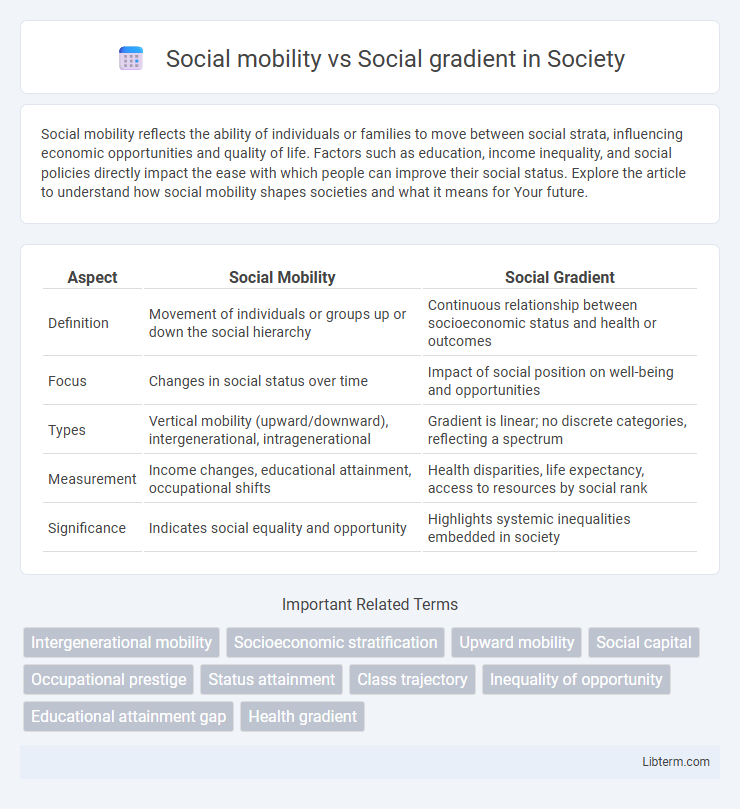Social mobility reflects the ability of individuals or families to move between social strata, influencing economic opportunities and quality of life. Factors such as education, income inequality, and social policies directly impact the ease with which people can improve their social status. Explore the article to understand how social mobility shapes societies and what it means for Your future.
Table of Comparison
| Aspect | Social Mobility | Social Gradient |
|---|---|---|
| Definition | Movement of individuals or groups up or down the social hierarchy | Continuous relationship between socioeconomic status and health or outcomes |
| Focus | Changes in social status over time | Impact of social position on well-being and opportunities |
| Types | Vertical mobility (upward/downward), intergenerational, intragenerational | Gradient is linear; no discrete categories, reflecting a spectrum |
| Measurement | Income changes, educational attainment, occupational shifts | Health disparities, life expectancy, access to resources by social rank |
| Significance | Indicates social equality and opportunity | Highlights systemic inequalities embedded in society |
Understanding Social Mobility
Social mobility measures the ability of individuals or groups to move between social strata, reflecting changes in income, education, or occupation over time. Understanding social mobility involves analyzing factors such as economic policies, educational access, and labor market conditions that facilitate or hinder upward or downward social movement. Researchers use longitudinal data and intergenerational studies to quantify social mobility and its impact on equality and social cohesion.
Defining the Social Gradient
The social gradient refers to the continuous relationship between socioeconomic status and health outcomes, where individuals at each step down the ladder experience worse health than those above. Unlike social mobility, which examines movement between social strata, the social gradient emphasizes the persistent disparities in health and wellbeing across all levels of society. This concept highlights that health inequalities are not just about the poor versus the rich but exist progressively across the entire social hierarchy.
Social Mobility: Key Theories and Concepts
Social mobility refers to the movement of individuals or groups within a social hierarchy, commonly analyzed through theories like structural mobility, which emphasizes changes due to economic and institutional shifts, and status attainment models that focus on educational and occupational achievements. Critical concepts include intergenerational mobility, highlighting changes in social status between parents and offspring, and intragenerational mobility, which examines shifts within an individual's lifetime. Understanding social mobility involves measuring both absolute mobility, reflecting tangible improvements in socioeconomic status, and relative mobility, which assesses changes in position within a fixed social structure.
Social Gradient: Structures and Impacts
The social gradient refers to the continuous and systematic relationship between social status and health outcomes, where individuals with lower socioeconomic positions consistently experience poorer health. Structures influencing the social gradient include income inequality, education disparities, and differential access to healthcare and social services. These factors create cumulative disadvantages, reinforcing health inequities across the lifespan and undermining social cohesion.
Factors Influencing Social Mobility
Social mobility is shaped by factors such as education access, economic opportunities, and social networks, which determine an individual's ability to change their socioeconomic status. In contrast, the social gradient reflects the consistent relationship between social position and health outcomes, influenced by income, occupation, and social environment. Key determinants impacting social mobility include family background, quality of schooling, labor market conditions, and systemic inequalities.
How Social Gradient Shapes Opportunities
The social gradient significantly shapes opportunities by creating a continuous spectrum of advantages and disadvantages linked to socioeconomic status, where individuals higher on the gradient often access better education, healthcare, and employment prospects. This gradient influences health outcomes, income potential, and overall life chances, reinforcing systemic inequalities within society. Unlike social mobility, which measures individual movement between social classes, the social gradient highlights how small differences in social position consistently affect opportunities and well-being across the population.
Social Mobility and Education
Social mobility refers to the ability of individuals or families to move between different social strata, often influenced by factors such as education level and access to learning opportunities. Education serves as a critical driver for upward social mobility by equipping people with skills and qualifications that increase employment prospects and income potential. Research consistently shows that higher educational attainment significantly enhances chances of improving socioeconomic status, thereby reducing social inequality over time.
Health Inequalities and the Social Gradient
Social mobility refers to the movement of individuals or groups within a social hierarchy, which can influence health outcomes by enabling access to better resources and healthcare. The social gradient in health illustrates that health status continuously improves as socio-economic position rises, reflecting pervasive health inequalities across all social levels. Understanding the social gradient emphasizes that addressing health disparities requires interventions targeting the entire socio-economic spectrum, not just the most disadvantaged groups.
Policies Addressing Mobility and Gradient
Policies addressing social mobility emphasize expanding access to quality education, job training, and economic opportunities to enable individuals to improve their socioeconomic status. Initiatives targeting the social gradient focus on reducing health and economic inequalities through progressive taxation, universal healthcare, and affordable housing programs that support lower-income groups. Effective policy frameworks integrate mobility-enhancing measures with gradient-reducing strategies to create more equitable societies.
Bridging the Gap: Strategies for Social Equity
Bridging the gap between social mobility and social gradient requires targeted policies that enhance equal access to education, healthcare, and economic opportunities across socioeconomic strata. Implementing progressive taxation, inclusive urban planning, and workforce development programs can reduce disparities embedded in social gradients while promoting upward social mobility. Evidence from OECD countries shows that coordinated social equity strategies significantly narrow income inequality and improve social outcomes for marginalized populations.
Social mobility Infographic

 libterm.com
libterm.com